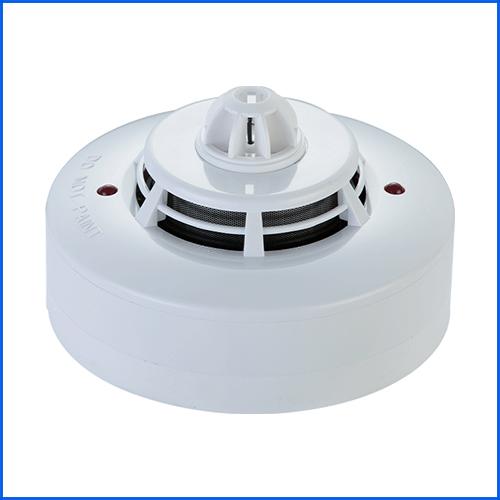DETECTORS
SMOKE DETECTOR

HEAT DETECTOR

FLAME DETECTOR

MULTI DETECTOR

A fire alarm system is a network of interconnected devices designed to detect and alert occupants of a building in the event of a fire or smoke. Its primary purpose is to provide early warning and facilitate the safe evacuation of people from the premises.
Components of a typical fire alarm system may include:
Smoke Detectors: These devices are designed to detect the presence of smoke in the air. There are different types of smoke detectors, such as ionization and photoelectric detectors, which use different mechanisms to sense smoke particles.
Heat Detectors: Heat detectors are designed to respond to changes in temperature. They activate when a certain temperature threshold is exceeded, indicating the presence of a fire.
Flame Detector: A flame detector is a specialized device used in fire detection systems to detect the presence of flames. It is designed to respond to the unique characteristics of flames, such as the infrared (IR) or ultraviolet (UV) radiation they emit. Flame detectors are commonly used in industrial settings, such as refineries, chemical plants, power plants, and warehouses, where the presence of flames can pose a significant hazard
Beam Detector: A beam detector, also known as a beam smoke detector or projected beam smoke detector, is a type of fire detection device used to sense the presence of smoke or fire in large open areas. It consists of a transmitter unit and a receiver unit that are installed opposite each other, with a beam of light passing between them
Multi Detector: A multi-detector, also known as a multi-sensor detector, is a type of fire detector that combines multiple detection technologies in a single device. It integrates different sensors to enhance fire detection capabilities and improve accuracy while reducing false alarms. The specific combination of sensors may vary depending on the manufacturer and model of the multi-detector. The combination of multiple sensors in a single device allows for more comprehensive and reliable fire detection. By utilizing different detection methods, multi-detectors can provide improved sensitivity and reduced false alarms, as the sensors can cross-verify and confirm the presence of a fire condition before activating an alarm.
Carbon Monoxide (CO) Detection: Some multi-detectors may incorporate carbon monoxide sensors to detect the presence of this odorless and potentially lethal gas. CO sensors can trigger an alarm when high levels of carbon monoxide are detected, indicating a potential fire or other hazardous conditions.
Gas Detection: Multi-detectors can also include sensors to detect other gases that may be present in certain environments, such as natural gas or propane. These sensors monitor the concentration of specific gases and activate an alarm if hazardous levels are detected.
Fire Alarm Control Panel (FACP): The FACP serves as the central command unit of the fire alarm system. It receives information from the detectors and activates the alarms, as well as communicates with other connected systems.
Alarm Notification Devices: These devices include sirens, strobe lights, and horns, which produce audible and visual signals to alert occupants of a fire emergency.
Manual Call Points: These are manual alarm activation devices typically installed near exits or in conspicuous locations. Pulling the handle or pressing the button initiates an alarm.
Monitoring System: Fire alarm systems can be connected to a monitoring service that receives alarm signals and notifies emergency responders.
Emergency Communication System: Some advanced fire alarm systems may include features like integrated voice evacuation systems or public address systems to provide instructions and guidance during an emergency.
It’s important to note that fire alarm systems can vary depending on the size, type, and purpose of the building. They are typically designed and installed in accordance with local fire codes and regulations to ensure maximum safety.
AMC & Maintenance: Regular testing, inspection, and maintenance are necessary to keep the system in proper working order.

SMOKE DETECTOR
These devices are designed to detect the presence of smoke in the air. There are different types of smoke detectors, such as ionization and photoelectric detectors, which use different mechanisms to sense smoke particles.

HEAT DETECTOR
Heat detectors are designed to respond to changes in temperature. They activate when a certain temperature threshold is exceeded, indicating the presence of a fire.

FLAME DETECTOR
A flame detector is a specialized device used in fire detection systems to detect the presence of flames. It is designed to respond to the unique characteristics of flames, such as the infrared (IR) or ultraviolet (UV) radiation they emit. Flame detectors are commonly used in industrial settings, such as refineries, chemical plants, power plants, and warehouses, where the presence of flames can pose a significant hazard

MULTI DETECTOR
A multi-detector, also known as a multi-sensor detector, is a type of fire detector that combines multiple detection technologies in a single device. It integrates different sensors to enhance fire detection capabilities and improve accuracy while reducing false alarms. The specific combination of sensors may vary depending on the manufacturer and model of the multi-detector. The combination of multiple sensors in a single device allows for more comprehensive and reliable fire detection. By utilizing different detection methods, multi-detectors can provide improved sensitivity and reduced false alarms, as the sensors can cross-verify and confirm the presence of a fire condition before activating an alarm.
Beam Detector: A beam detector, also known as a beam smoke detector or projected beam smoke detector, is a type of fire detection device used to sense the presence of smoke or fire in large open areas. It consists of a transmitter unit and a receiver unit that are installed opposite each other, with a beam of light passing between them
Carbon Monoxide (CO) Detection: Some multi-detectors may incorporate carbon monoxide sensors to detect the presence of this odorless and potentially lethal gas. CO sensors can trigger an alarm when high levels of carbon monoxide are detected, indicating a potential fire or other hazardous conditions.
Gas Detection: Multi-detectors can also include sensors to detect other gases that may be present in certain environments, such as natural gas or propane. These sensors monitor the concentration of specific gases and activate an alarm if hazardous levels are detected.
Fire Alarm Control Panel (FACP): The FACP serves as the central command unit of the fire alarm system. It receives information from the detectors and activates the alarms, as well as communicates with other connected systems.
Alarm Notification Devices: These devices include sirens, strobe lights, and horns, which produce audible and visual signals to alert occupants of a fire emergency.
Manual Call Points: These are manual alarm activation devices typically installed near exits or in conspicuous locations. Pulling the handle or pressing the button initiates an alarm.
Monitoring System: Fire alarm systems can be connected to a monitoring service that receives alarm signals and notifies emergency responders.
Emergency Communication System: Some advanced fire alarm systems may include features like integrated voice evacuation systems or public address systems to provide instructions and guidance during an emergency.
It’s important to note that fire alarm systems can vary depending on the size, type, and purpose of the building. They are typically designed and installed in accordance with local fire codes and regulations to ensure maximum safety.
AMC & Maintenance: Regular testing, inspection, and maintenance are necessary to keep the system in proper working order.
